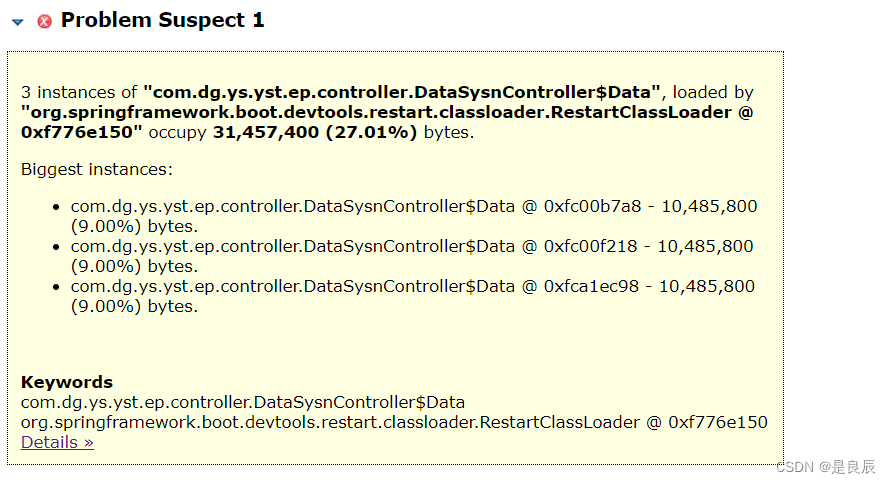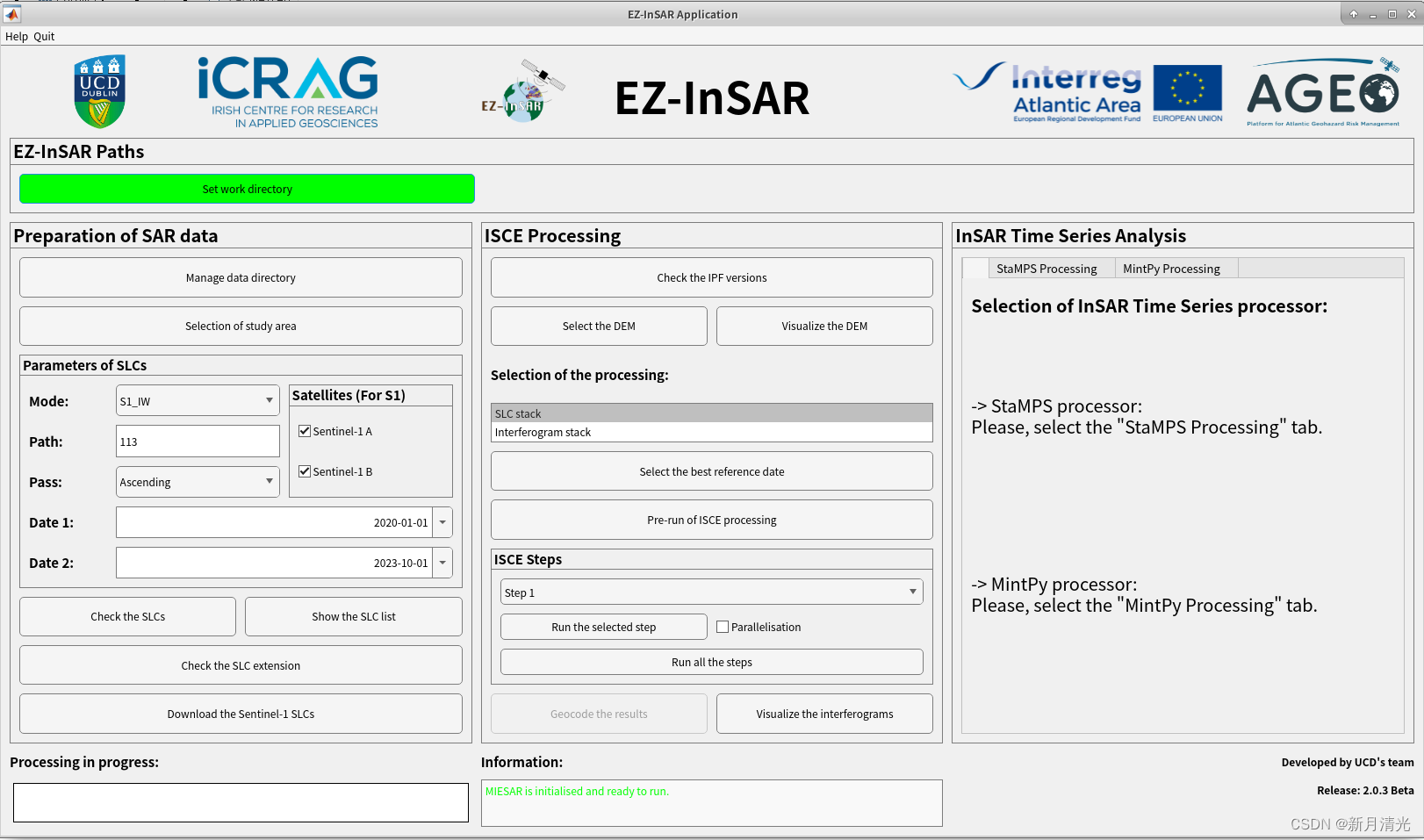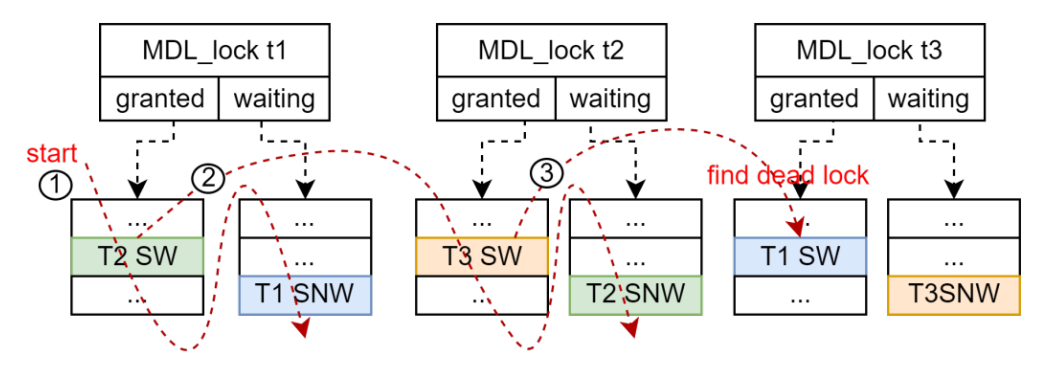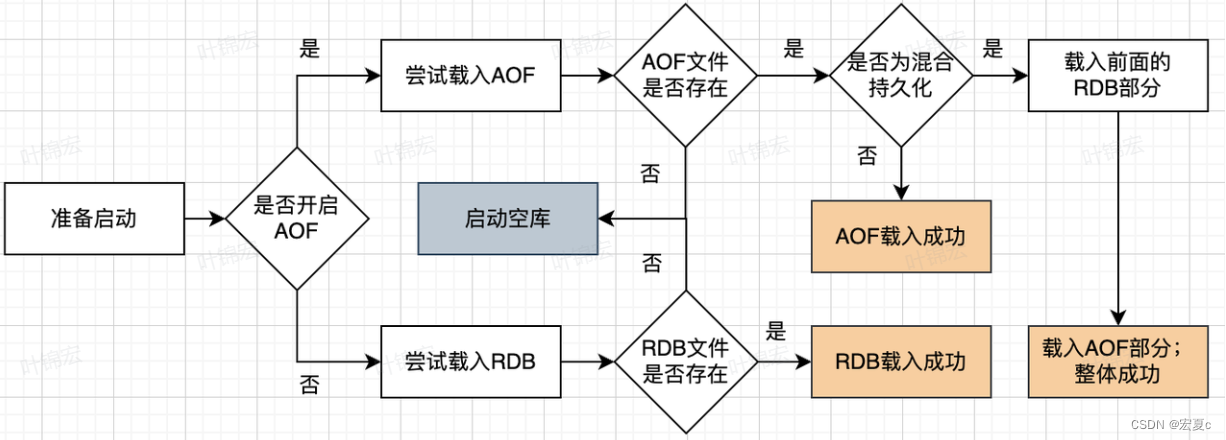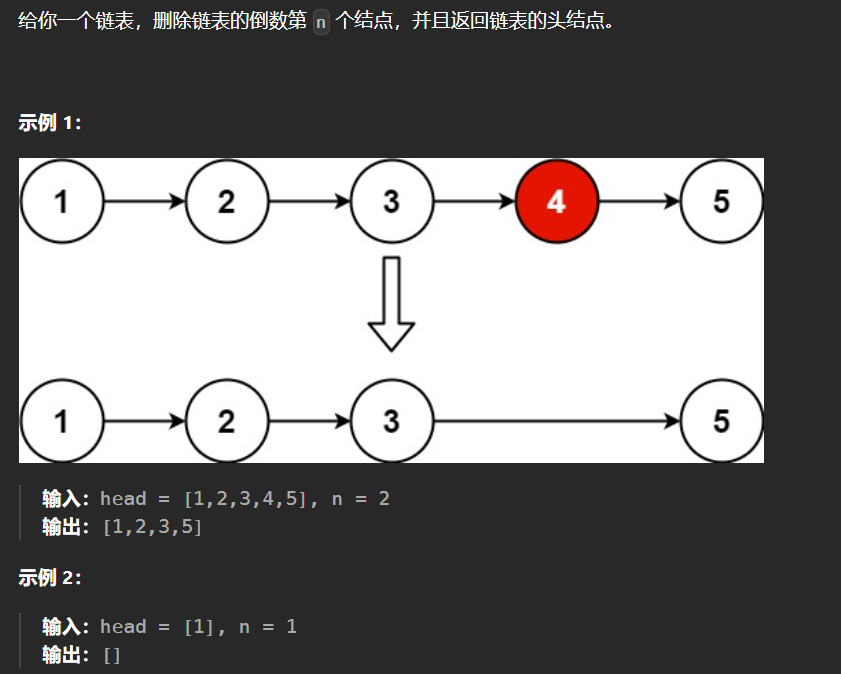敏感性分析
- Sobol
- Morris
- Fourier Amplitude Sensitivity Test (FAST)
- Random Balance Designs - Fourier Amplitude Sensitivity Test (RBD-FAST)
- Delta Moment-Independent Measure
- Derivative-based Global Sensitivity Measure (DGSM)
- Fractional Factorial Sensitivity Analysis
- High Dimensional Model Representation
- PAWN
- Regional Sensitivity Analysis
- Discrepancy Sensitivity Indices
注:最后两种暂时还没有集成到SALib1.4.7中,需要手动添加官网相关代码。
已手动整理相关代码, 此处跳转。
一个模型有自变量(输入数据)和因变量(输出结果),因变量随自变量的变化而变化,其变化程度与自变量、因变量两者之间关系的强弱决定,敏感性分析便是对强弱关系进行定量讨论,通常将其定量结果称为敏感指数。
敏感指数由三种形式组成。一阶指数衡量单个自变量对因变量方差的贡献;二阶指数衡量两个自变量之间的交互作用对因变量方差的贡献;全阶指数衡量衡量所有自变量(包括一阶效应和其他高阶交互作用)对因变量方差的贡献。
为了方便进行敏感性分析,我们使用Python的敏感性分析库SALib完成计算工作,其包含若干个分析方案,具体如下。
所有方法均以以下相同problem为自变量
定义自变量
problem = {'num_vars': 3,'names': ['x1', 'x2', 'x3'],'bounds': [[-3.14159265359, 3.14159265359],[-3.14159265359, 3.14159265359],[-3.14159265359, 3.14159265359]]
}
Sobol
# 生成自变量
SALib.sample.sobol.sample(problem: Dict, N: int, *, calc_second_order: bool = True, scramble: bool = True, skip_values: int = 0, seed: int | Generator | None = None)
"""
problem: 自变量定义
N: 样本数量,建议为2的倍数,且不大于skip_values
calc_second_order: 是否需要二阶指数计算,默认为True
scramble: 是否添加干扰,默认为True
skip_values: 需要跳过的序列数目,建议为2的倍数,默认是0
seed: 随机种子
"""# 敏感分析
SALib.analyze.sobol.analyze(problem, Y, calc_second_order=True, num_resamples=100, conf_level=0.95, print_to_console=False, parallel=False, n_processors=None, keep_resamples=False, seed=None)
"""
problem: 自变量定义
Y: 因变量
calc_second_order: 是否需要二阶指数计算,默认为True
num_resamples: 重采样次数,默认为100
conf_level: 置信区间水平,默认为0.95
print_to_console: 是否输出到操作台,默认为False
parallel: 是否并行分析,默认为False
n_processors: 并行进程数,当parallel=True时使用
keep_resamples: 是否存储中间重采样结果,默认为False
seed: 随机种子
"""
# 结果
print(Si)
# {
# 'S1':
# array([0.31683154, 0.44376306, 0.01220312]),
# 'S1_conf':
# array([0.0612548 , 0.05702573, 0.05750855]),
# 'ST':
# array([0.55586009, 0.44189807, 0.24467539]),
# 'ST_conf':
# array([0.07651133, 0.04224496, 0.02889387]),
# 'S2':
# array([[ nan, 0.00925429, 0.23817211],
# [ nan, nan, -0.0048877 ],
# [ nan, nan, nan]]),
# 'S2_conf':
# array([[ nan, 0.08265217, 0.11277348],
# [ nan, nan, 0.06331599],
# [ nan, nan, nan]])
# }
Morris
# 生成自变量
SALib.sample.morris.sample(problem: Dict, N: int, num_levels: int = 4, optimal_trajectories: int = None, local_optimization: bool = True, seed: int = None)
"""
problem: 自变量定义
N: 轨迹数量
num_levels: 网格层数,偶数,默认为4
optimization_trajectories: 要采样的最佳轨迹数量,范围为2到N
local_optimization: 是否使用局部优化,默认为True
seed: 随机种子
"""# 敏感分析
SALib.analyze.morris.analyze(problem: Dict, X: ndarray, Y: ndarray, num_resamples: int = 100, conf_level: float = 0.95, scaled: bool = False, print_to_console: bool = False, num_levels: int = 4, seed=None)
"""
problem: 自变量定义
X: 自变量
Y: 因变量
calc_second_order: 是否需要二阶指数计算,默认为True
num_resamples: 重采样次数,默认为100
conf_level: 置信区间水平,默认为0.95
print_to_console: 是否输出到操作台,默认为False
parallel: 是否并行分析,默认为False
n_processors: 并行进程数,当parallel=True时使用
keep_resamples: 是否存储中间重采样结果,默认为False
seed: 随机种子
"""
# 结果
print(Si)
# mu mu_star sigma mu_star_conf
# x1 7.354122 7.354122 6.242112 3.968815e-01
# x2 -0.110250 7.875000 7.878168 5.248703e-15
# x3 0.362430 6.486250 9.000676 3.725592e-01
# {
# 'names': ['x1', 'x2', 'x3'],
# 'mu': array([ 7.35412153, -0.11025 , 0.36243017]),
# 'mu_star': masked_array(
# data=[7.354121529806647, 7.875000000000724, 6.4862503552631114],
# mask=[False, False, False],
# fill_value=1e+20),
# 'sigma': array([6.24211213, 7.87816828, 9.000676 ]),
# 'mu_star_conf': masked_array(
# data=[0.39688154270651804, 5.248702595241132e-15, 0.37255924946508345],
# mask=[False, False, False],
# fill_value=1e+20)
# }

Fourier Amplitude Sensitivity Test (FAST)
# 生成自变量
SALib.sample.fast_sampler.sample(problem, N, M=4, seed=None)
"""
problem: 自变量定义
N: 样本数量
M: 干扰参数,默认为4
seed: 随机种子
"""# 敏感分析
SALib.analyze.fast.analyze(problem, Y, M=4, num_resamples=100, conf_level=0.95, print_to_console=False, seed=None)
"""
problem: 自变量定义
Y: 因变量
M: 干扰参数,默认为4
num_resamples: 重采样次数,默认为100
conf_level: 置信区间水平,默认为0.95
print_to_console: 是否输出到操作台,默认为False
seed: 随机种子
"""
# 结果
print(Si)
# {
# 'S1': [0.3081232160181247, 0.4420505304594682, 1.0406181235617822e-28],
# 'ST': [0.5519123814033295, 0.46920370910272835, 0.23930621330436663],
# 'S1_conf': [0.013434507989869757, 0.015813518018138756, 0.015093897483613204],
# 'ST_conf': [0.041141026199615446, 0.04117206451357777, 0.04071053209490691],
# 'names': ['x1', 'x2', 'x3']
# }
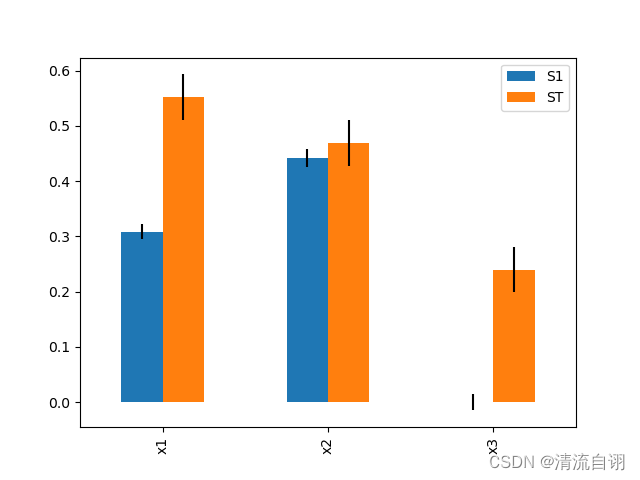
Random Balance Designs - Fourier Amplitude Sensitivity Test (RBD-FAST)
# 生成自变量
SALib.sample.latin.sample(problem, N, seed=None)
"""
problem: 自变量定义
N: 样本数量
seed: 随机种子
"""# 敏感分析
SALib.analyze.rbd_fast.analyze(problem, X, Y, M=10, num_resamples=100, conf_level=0.95, print_to_console=False, seed=None)
"""
problem: 自变量定义
X: 自变量
Y: 因变量
M: 干扰参数,默认为4
num_resamples: 重采样次数,默认为100
conf_level: 置信区间水平,默认为0.95
print_to_console: 是否输出到操作台,默认为False
seed: 随机种子
"""
# 结果
print(Si)
# {
# 'S1': [0.31806056031674595, 0.4450789986938868, 1.5359880927191816e-06],
# 'S1_conf': [0.0556645519811434, 0.07578207765070516, 0.0214559062090626],
# 'names': ['x1', 'x2', 'x3']
# }

Delta Moment-Independent Measure
# 敏感分析
SALib.analyze.delta.analyze(problem: Dict, X: ndarray, Y: ndarray, num_resamples: int = 100, conf_level: float = 0.95, print_to_console: bool = False, seed: int = None, y_resamples: int = None, method: str = 'all')
"""
problem: 自变量定义
X: 自变量
Y: 因变量
num_resamples: 重采样次数,默认为100
conf_level: 置信区间水平,默认为0.95
print_to_console: 是否输出到操作台,默认为False
seed: 随机种子
y_resamples: 重采样时使用的样本数
method: 计算"delta"、"sobol"或两者"all",默认为all
"""
# 结果
print(Si)
# delta delta_conf S1 S1_conf
# x1 0.194729 0.021577 0.302742 0.039161
# x2 0.254878 0.022195 0.313650 0.052195
# x3 0.134645 0.020917 0.006901 0.010473
# {
# 'delta': array([0.19472928, 0.25487771, 0.13464494]),
# 'delta_conf': array([0.02157656, 0.02219531, 0.02091679]),
# 'S1': array([0.30274202, 0.31365005, 0.00690086]),
# 'S1_conf': array([0.03916104, 0.0521946 , 0.01047288]),
# 'names': ['x1', 'x2', 'x3']
# }

Derivative-based Global Sensitivity Measure (DGSM)
# 敏感分析
SALib.analyze.dgsm.analyze(problem, X, Y, num_resamples=100, conf_level=0.95, print_to_console=False, seed=None)
"""
problem: 自变量定义
X: 自变量
Y: 因变量
num_resamples: 重采样次数,默认为100
conf_level: 置信区间水平,默认为0.95
print_to_console: 是否输出到操作台,默认为False
seed: 随机种子
"""
# 结果
print(Si)
# {
# 'vi': array([ 7.73312725, 24.37534083, 11.34887321]),
# 'vi_std': array([16.43522688, 17.35675534, 24.40109617]),
# 'dgsm': array([2.24329014, 7.07100245, 3.29217592]),
# 'dgsm_conf': array([1.01703239, 1.0872397 , 1.60391344]),
# 'names': ['x1', 'x2', 'x3']
# }

Fractional Factorial Sensitivity Analysis
# 生成自变量
SALib.sample.ff.sample(problem, seed=None)
"""
problem: 自变量定义
seed: 随机种子
"""# 敏感分析
SALib.analyze.ff.analyze(problem, X, Y, second_order=False, print_to_console=False, seed=None)
"""
problem: 自变量定义
X: 自变量
Y: 因变量
second_order: 是否需要二阶指数计算,默认为True
print_to_console: 是否输出到操作台,默认为False
seed: 随机种子
"""
# 结果
print(Si)
# {
# 'names': ['x1', 'x2', 'x3', 'dummy_0'],
# 'ME': array([-2.22146819e-12, 0.00000000e+00, 0.00000000e+00, 0.00000000e+00]),
# 'interaction_names': [('x1', 'x2'), ('x1', 'x3'), ('x2', 'x3'), ('x1', 'dummy_0'), ('x2', 'dummy_0'), ('x3', 'dummy_0')],
# 'IE': [0.0, 0.0, 0.0, 0.0, 0.0, 0.0]
# }
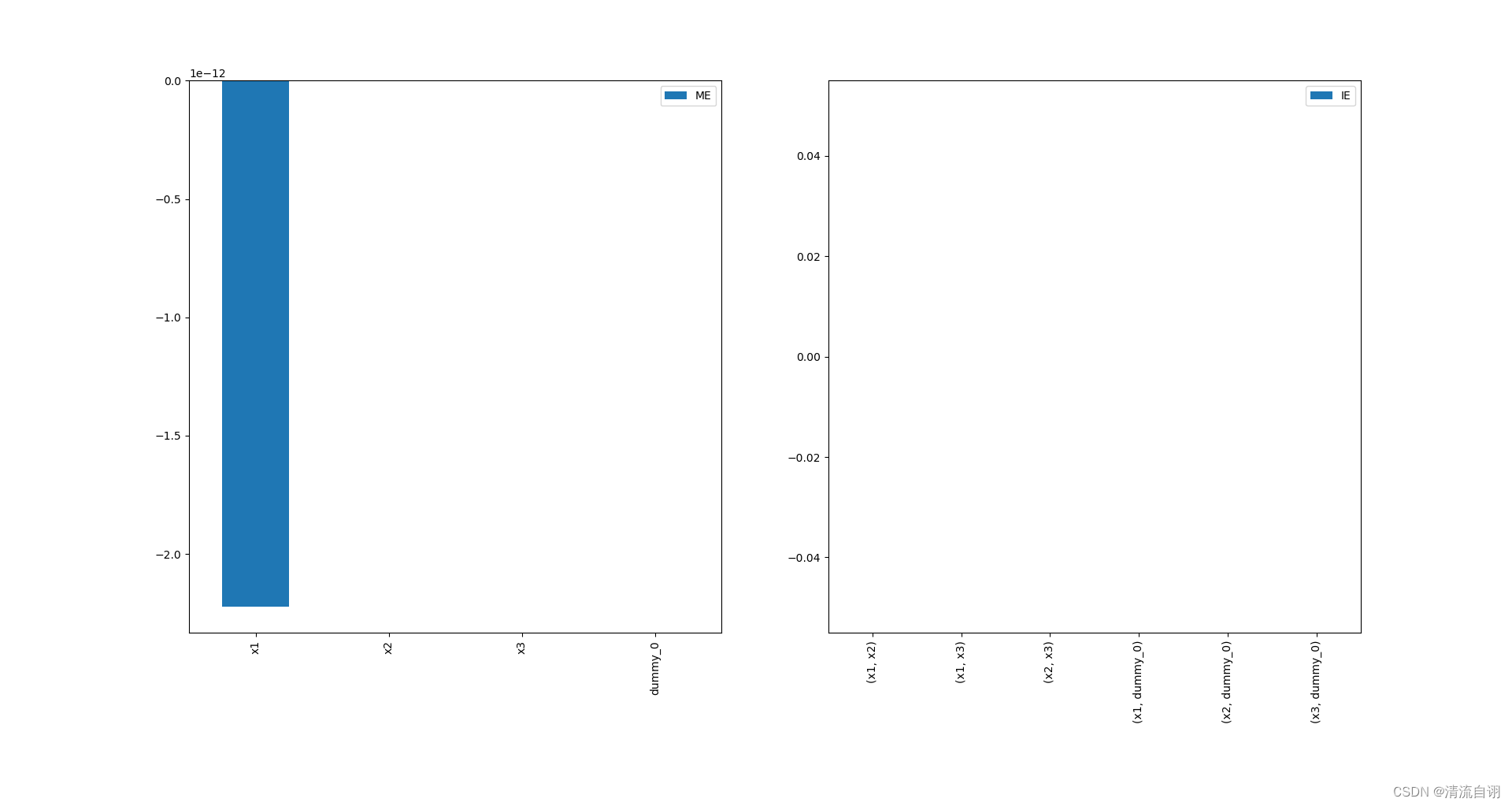
High Dimensional Model Representation
# 敏感分析
SALib.analyze.hdmr.analyze(problem: Dict, X: ndarray, Y: ndarray, maxorder: int = 2, maxiter: int = 100, m: int = 2, K: int = 20, R: int = None, alpha: float = 0.95, lambdax: float = 0.01, print_to_console: bool = False, seed: int = None)
"""
problem: 自变量定义
X: 自变量,长度为N
Y: 因变量
maxorder: 最大扩展阶数,范围1-3,默认为2
maxiter: 最大拟合迭代次数,范围1-1000,默认为100
m: B-spline间隔数,范围2-10,默认为2
K: bootstrap迭代次数,范围1-100,默认为20
R: bootstrap样本数,范围100-N/2。默认为N/2,当K为1,R默认为Y的长度
alpha: 置信区间 F 检验,默认为0.95
lambdax: 正则化项,范围0-10,默认0.01
print_to_console: 是否输出到操作台,默认为False
seed: 随机种子
"""
# 结果
print(Si)
# {
# 'Sa': array([0.32098624, 0.32706979, 0.00551071, 0.01372589, 0.22420121,
# 0.03167076]),
# 'Sa_conf': array([0.03449847, 0.03054272, 0.008012 , 0.00690539, 0.03165136,
# 0.01684393]),
# 'Sb': array([ 0.01875264, -0.01008509, -0.00085121, 0.00878864, 0.01348094,
# 0.03473462]),
# 'Sb_conf': array([0.0214207 , 0.03050578, 0.00305786, 0.00632993, 0.02066726,
# 0.02149721]),
# 'S': array([0.33005615, 0.33421506, 0.00512609, 0.01459155, 0.20722952,
# 0.04286532]),
# 'S_conf': array([0.03056583, 0.03283559, 0.0086171 , 0.00692596, 0.0308207 ,
# 0.02360502]),
# ...............
# ...............
# }
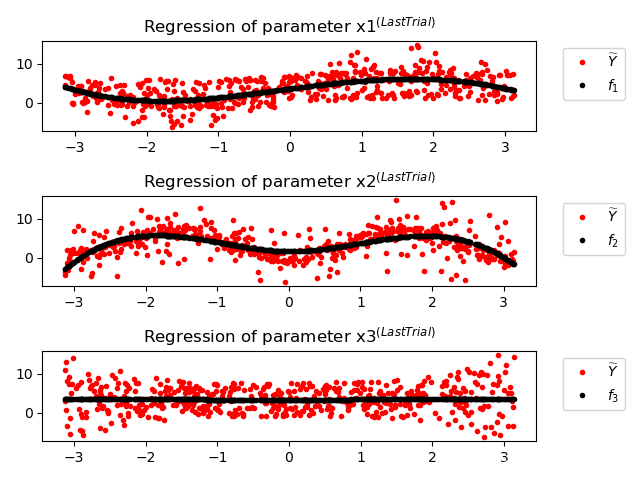
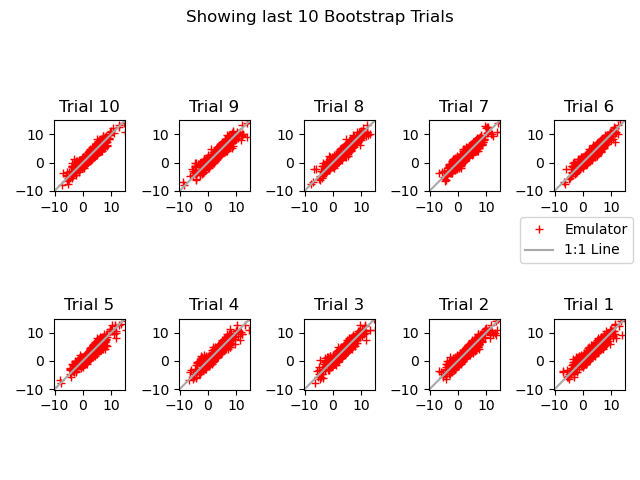
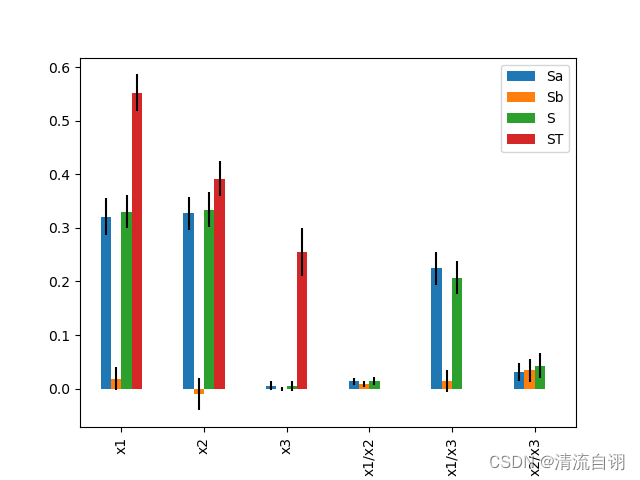
PAWN
# 敏感分析
SALib.analyze.pawn.analyze(problem: Dict, X: ndarray, Y: ndarray, S: int = 10, print_to_console: bool = False, seed: int = None)
"""
problem: 自变量定义
X: 自变量,长度为N
Y: 因变量
S: 调节间隔,默认为10
print_to_console: 是否输出到操作台,默认为False
seed: 随机种子
"""
# 结果
print(Si)
# {
# 'minimum': array([0.172, 0.215, 0.07 ]),
# 'mean': array([0.2446899 , 0.35838889, 0.12805354]),
# 'median': array([0.261 , 0.3875, 0.114 ]),
# 'maximum': array([0.359, 0.489, 0.257]),
# 'CV': array([0.24174122, 0.26268279, 0.40149537]),
# 'names': ['x1', 'x2', 'x3']
# }

Regional Sensitivity Analysis
# 敏感分析
SALib.analyze.rsa.analyze(problem: Dict, X: ndarray, Y: ndarray, bins: int = 20, target: str = 'Y', print_to_console: bool = False, seed: int = None)
"""
problem: 自变量定义
X: 自变量
Y: 因变量
bins: 使用的箱数,默认为20
target: 评估自变量("X")或因变量("Y"),默认为"Y"
print_to_console: 是否输出到操作台,默认为False
seed: 随机种子
"""
# 结果
print(Si)
# {
# 'x1': array([ 0.89094312, 0.76391302, 0.6901172 , 0.07445683, 0.00810598,
# -0.02019611, -0.01031206, -0.02119982, -0.01553581, 0.00392679,
# -0.00631403, 0.01199807, -0.0249512 , 0.01452995, 0.11153721,
# -0.01175163, 0.3564372 , 0.57950908, 0.78215635, 1. ]),
# 'x2': array([ 0.04154606, 0.0830033 , 0.09267739, 0.05356006, 0.05618751,
# 0.02343257, 0.0891207 , 0.02911934, -0.00066498, -0.01310919,
# -0.00965545, -0.00484718, 0.00592457, -0.00896379, 0.06430754,
# 0.09513276, 0.05469668, 0.05782315, 0.0256584 , 0.03686238]),
# 'x3': array([ 0.83197838, 0.0348991 , 0.03329039, 0.02259925, 0.01671094,
# 0.01156657, 0.014363 , 0.01250926, -0.02117361, 0.00110074,
# -0.01738245, 0.02128902, -0.00589163, -0.01071005, 0.04296997,
# 0.01399239, 0.00837767, -0.00838735, 0.04364362, 0.79882026]),
# 'names': ['x1', 'x2', 'x3'],
# 'bins': array([0. , 0.05, 0.1 , 0.15, 0.2 , 0.25, 0.3 , 0.35, 0.4 , 0.45, 0.5 ,
# 0.55, 0.6 , 0.65, 0.7 , 0.75, 0.8 , 0.85, 0.9 , 0.95]),
# 'target': 'Y'
# }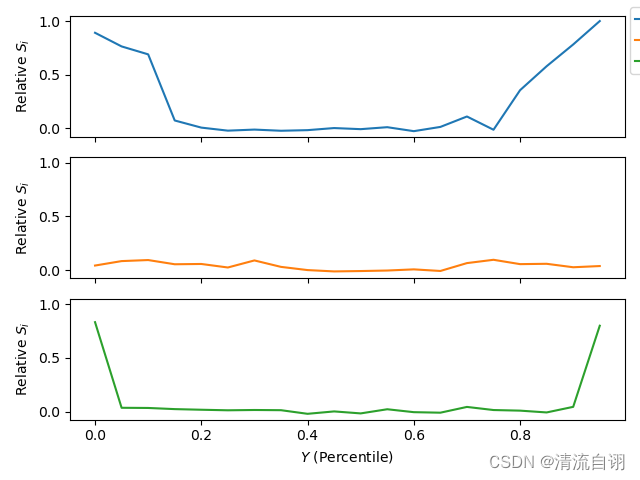
Discrepancy Sensitivity Indices
# 敏感分析
SALib.analyze.discrepancy.analyze(problem: Dict, X: ndarray, Y: ndarray, method: str = 'WD', print_to_console: bool = False, seed: int = None)
"""
problem: 自变量定义
X: 自变量
Y: 因变量
method: 差异类型("WD", "CD", "MD", "L2-star"),默认为"WD"。
print_to_console: 是否输出到操作台,默认为False
seed: 随机种子
"""
# 结果
print(Si)
# {
# 's_discrepancy': array([0.33467611, 0.33305819, 0.3322657 ]),
# 'names': ['x1', 'x2', 'x3']
# }
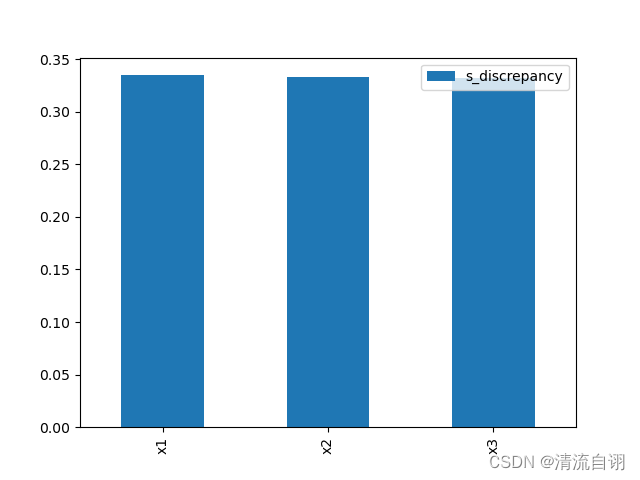

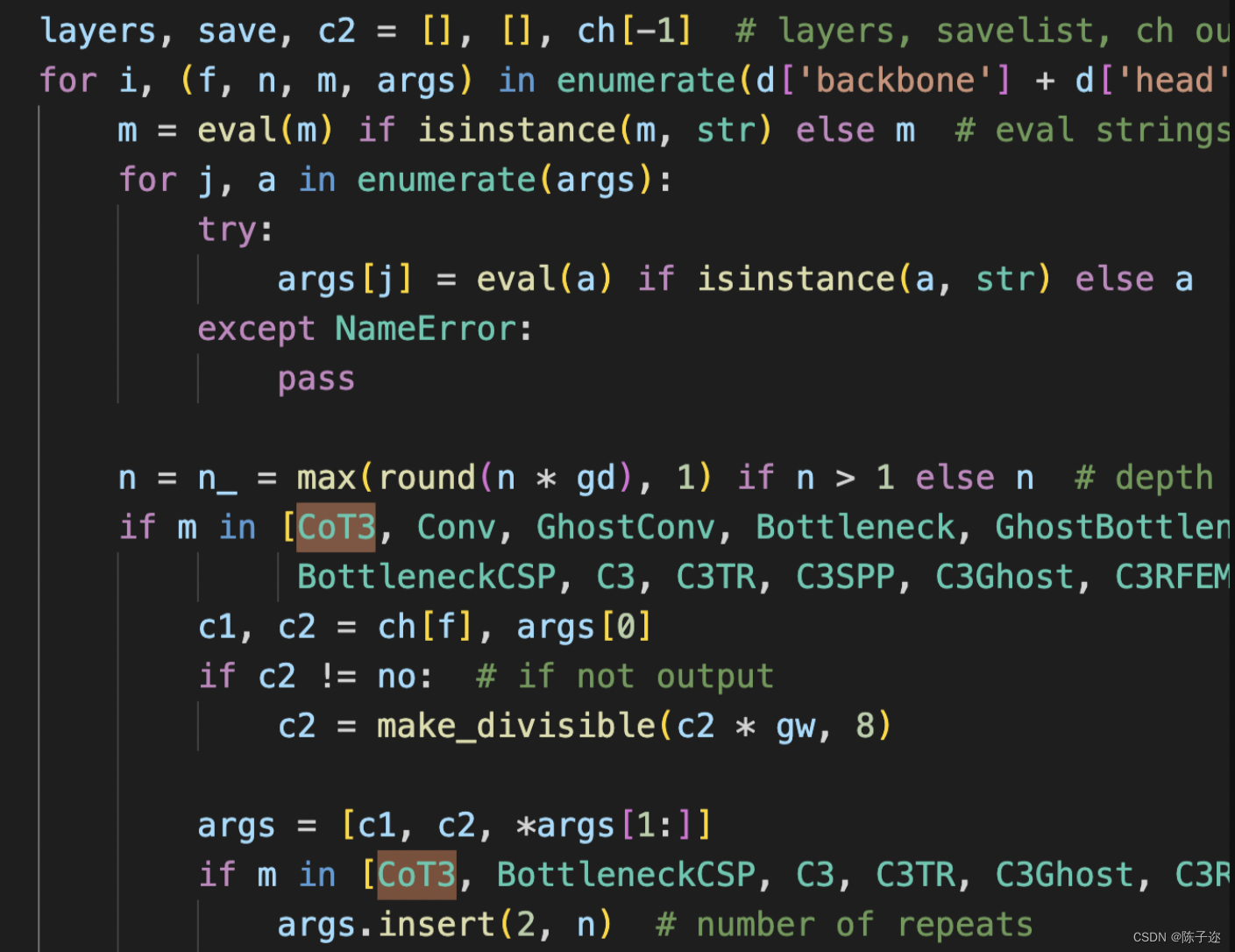


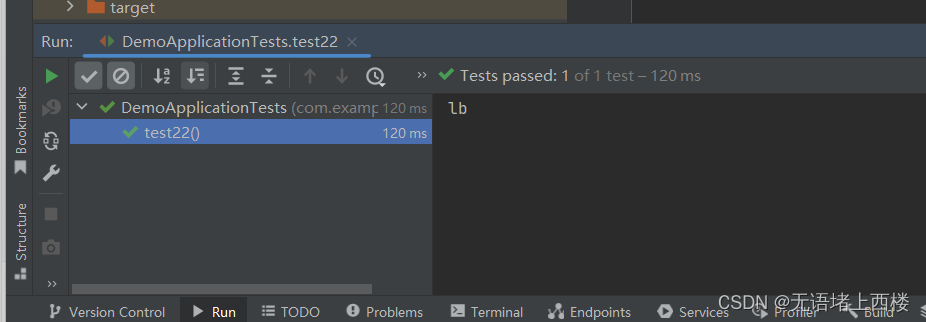

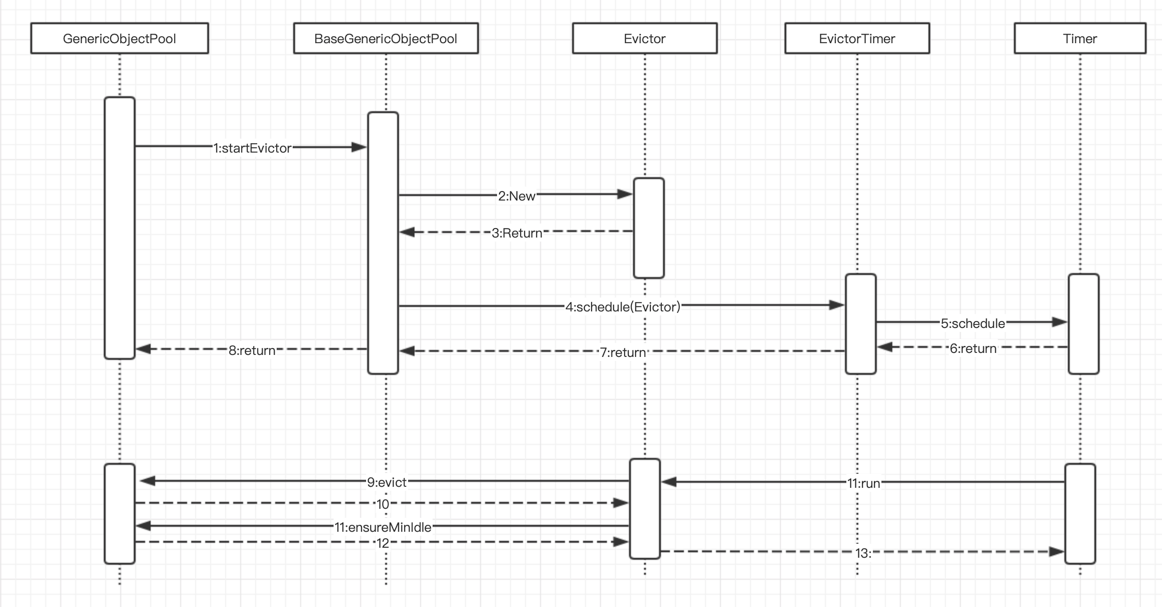



![[红明谷CTF 2021]write_shell %09绕过过滤空格 ``执行](https://img-blog.csdnimg.cn/d4689eed5afe4de4a687cd0cd2eb865d.png)
